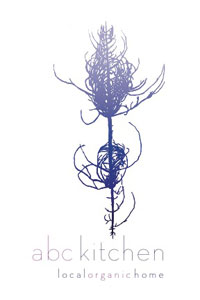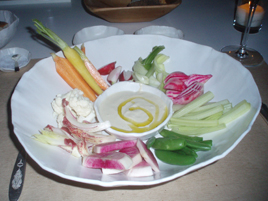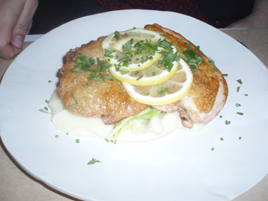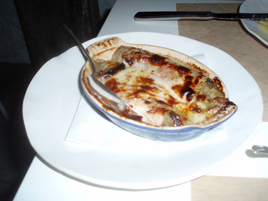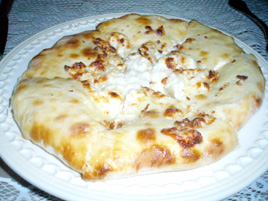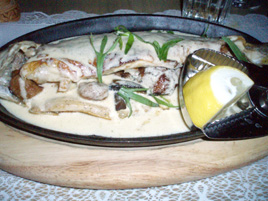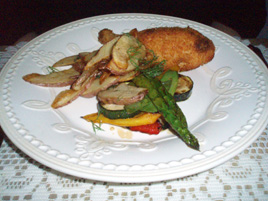
In New York City, what happens when your landlord demands a $600,000 rent increase? If you’re father-and-daughter restaurateurs Tony and Marisa May, you spend $7 million on a super-sized, glitzy replacement thirty-three blocks south. That would be new and hip SD26, just steps away from Madison Park, replacing dull and dowdy San Domenico, on Central Park South.
The old place carried two stars in the Times, but we gave it zero two years ago, after a $300 dinner where almost everything went wrong. We’re sure that San Domenico was capable of serving better meals, but clearly the restaurant was no longer part of the culinary conversation, and hadn’t been for a long time.
Tony May probably wouldn’t admit that his restaurant had become irrelevant, but the name change is significant. Bouley, Aureole, and Oceana all moved within the last year, while keeping their old names. “San Domenico” no longer had the same cachet. Perhaps it had become a liability. SD26 keeps the initials, but in the new neighborhood it’s a tabula rasa.
If the Mays wanted contrast, they’ve achieved it. Massimo Vignelli’s design is stunning. Although the space is more than double the size of San Domenico, it is divided into several smaller sections: a wine bar, a casual café, a large dining room with smaller alcoves, and a soaring balcony with intimate tables overlooking the action.
 The menu, still under chef Odette Fada, received a long-overdue facelift. Prices are lower, and most items (even mains) are available in half portions. There is no longer a chintzy $2.50 sharing charge. Tony May told the Times that the average check size will be $20 less than at San Domenico. The wine list, too, has plenty of bottles below $50; uptown, I struggled to find anything below $75.
The menu, still under chef Odette Fada, received a long-overdue facelift. Prices are lower, and most items (even mains) are available in half portions. There is no longer a chintzy $2.50 sharing charge. Tony May told the Times that the average check size will be $20 less than at San Domenico. The wine list, too, has plenty of bottles below $50; uptown, I struggled to find anything below $75.
The Mays have embraced technology, perhaps to a fault. The wine bar has a high-gloss wine dispenser, which accepts a “smart card” and dispenses pours one, two, or four ounces at a time. A sommelier told me that it’s the latest thing in Italy, but I am not sure that New Yorkers will be fond of it.
The wine list comes on a wireless electronic tablet that resembles a small notebook computer. Tony May told the Times, “People don’t know what to do anymore with those big leatherbound books. So an electronic wine list on a computer you hold in your hand will tell you as much about the wine as you want to know. It’s intuitive. The idea is to make it so simple that even a computer illiterate can operate it.”
I quickly figured out the user interface, but found it frustrating. On a traditional wine list, I can flip through the pages quickly, getting an instant sense of its breadth and depth. A small screen that shows only a few bottles at a time is disorienting. You have no idea what you’re not seeing. It’s probably a lot, given an inventory of 1,000 bottles. Response time isn’t bad, but turning a page is a lot faster.
At least no one can accuse the Mays of resting on their laurels. Both were in the house on Saturday evening, and it appeared they were stopping at every table to say hello. The crowd was a mix of former regulars who followed the restaurant downtown, and the younger generation the Mays covet.
Even Tony May himself is now business casual. At an adjoining table, we heard one of his long-time customers say, “I’ve never seen you before without a tie.” The lovely Marisa May got a makeover too, though unlike San Domenico, she did not need one. Formerly a blonde, she became a brunette.



The menu offers a long selection of cured meats and salumi, ranging from $7.50 (most) to $19 apiece. We tried the Pancetta (cured pork belly with garlic, spices, and freshly ground pepper), Sopressata (spicy salami with pepper and garlic) and Lard (pork fat cured with herbs, salt, and pepper).
At least, that’s what we thought we had. When the bill arrived, all three had different prices, even though they were listed at $7.50 apiece on the menu. After a conference, the bill was adjusted, though I am still not sure whether we were served the right items—many of them are similar—but the top-right photo is definitely the lard.
Anyhow, it’s an impressive selection, and well worth sampling, but sliced meats shouldn’t have taken 20 minutes to come out.


Pappardelle with Wild Boar Ragu ($25; above left) was a lovely dish—carried over from the old place, if I recall correctly. Boar is a lean meat, and it needed more seasoning to bring out the flavor. The long, loopy noodles were a bit unwieldy, and we thought the kitchen should divide the portion for us, instead of leaving that task to us.
According to the website, the menu at SD26 has been designed to consider “today’s nutritional values.” Perhaps that is the reason why both entrées felt a bit like spa food. Red Snapper ($29.50; above right) was simply prepared, without any sauce. Smoked Lobster ($35; below left) with porcini mushrooms and orange segment was equally simple. Though I can’t find fault with the cooking, we felt that at these prices there ought to be more excitement on the plate.


Deconstructed Tiramisu ($9; above right) was certainly not an improvement on the more familiar version.
We were seated at a quiet corner table that Marisa May told us was her favorite spot in the restaurant, in a bright red alcove (photo above). The bustling main dining room could get noisy when it is full. In our cosy little alcove, we had no such problems. Service, as noted, is not yet as smooth as it ought to be, though none of the little glitches detracted from our evening.
The decision to upend the old San Domenico—both physically and philosophically—cannot have come easily. The Mays abandoned everything they had known, for an expensive remake that their old clients might not follow, and that new ones might not embrace. Once they decided that the old place could not be replicated, there were no half-measures or compromises. I have to admire them for that.
SD26 is not, as yet, wholly successful. However, there is much to admire. With so much riding on the outcome, I suspect that there are good times to come.
SD26 (19 E. 26th Street at Madison Square Park)
Food: *½
Service: **
Ambiance: **
Overall: **
 Tuesday, August 3, 2010 at 09:21AM
Tuesday, August 3, 2010 at 09:21AM 

 The bread service (left) was wonderful: cheese bread and cornmeal, with honey-doused mascarpone for dipping. Matters turned quickly south when the appetizers arrived.
The bread service (left) was wonderful: cheese bread and cornmeal, with honey-doused mascarpone for dipping. Matters turned quickly south when the appetizers arrived.






